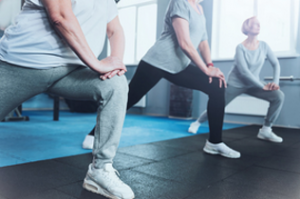Indeed, it goes without saying that all your body parts have a crucial function to your daily existence. But, the knee is one element that is particularly important to your mobility.
You absolutely need the knee in order to bend, move from side to side, and get up or down from a standing to sitting position. Consequently, having this joint in top working condition is essential for your maneuverability.
But the truth is the knee gets damaged from activities, arthritis, sports injuries, and simple everyday wear and tear. All of these conditions cause pain.
One of the ways to reduce this discomfort is by stretching quadriceps for knee pain.
As the biggest joint in the body, the knee is composed of tendons, muscles, ligaments and kneecap bones. It is used in every movement, making it really susceptible to injury. In fact, you don’t have to be doing anything strenuous to cause pain in the knee area.
A simple wrong move when turning around or getting out of the car can twist the knee enough to make you screech out in agony.
Additionally, the knee joint has to support the weight of the whole body. That means whatever pressure you force it to bear can do serious harm.
Pounding your feet on concrete when running, jumping from high heights while landing on hard surfaces, playing football, tennis or racquet ball all have the capacity to cause damage to one or more of the elements in the knee.
Before we explain how stretching quadriceps for knee pain works, it is important to know where the quadriceps are, and what they are composed of.
The quads are in the front area of the leg between the groin and the knee. They have four muscles called:

- Rectus femoris
- Vastus intermedius
- Vastus lateralis
- Vastus medialis
A Latin term for four-headed muscle, the quadriceps are the strongest of all muscles in the body. Their inner workings are a complex operation that work in sync with other muscles, tendons, and the knee.
Because of the specific harmony between the quads and the knee, stretching quadriceps for knee pain makes complete sense as a treatment to relieve those aches and pains in the knee joint.
Quadriceps Muscles Exercises For Knee Pain
Since the quads are supposed to carry their share of the load in performing in conjunction with the knee, the quads need to be strong, too. One without the other is not a good compromise for comfortable movement.
That means that one of the very first exercises you should consider is strengthening the quads. But to add to that, you must understand how to strengthen quads without hurting knees.
No doubt, this is a delicate balance. You want to stretch in order to reduce knee pain, but at the same time, you don’t want to do further damage or cause more pain.
The easiest, yet most effect way to stretch out the quads is by bending the leg at the knee and holding the foot right up to the buttock.
If you are not strong enough to do this without support, use your other hand to gently touch a kitchen chair, the back of the sofa, the wall, or anything that won’t move around.
Keep the lines of your body straight and don’t force the leg to go any higher than it is able. As you do more repetitions each day, the heel will eventually touch the buttock.
Try to hold the pose for at least thirty seconds, then switch legs. Again, if you are not able to hold the pose, or it is painful to do, then rest, and pick up again, only do what your body allows.
Additionally, a hamstring stretch can also help. Tight hamstrings do cause knee discomfort. So when completing your routine to strengthen the quads, adding in a hamstring stretch is beneficial.
The hamstrings are at the back of the legs. After you finish your quad stretch while standing up, lie down on the floor to start your hamstring stretch.
Simply, bring your knee up to your body, wrapping your arms around the knee. Try to get it as close to your body as possible. Hold the pose for about twenty seconds.
Switch legs. Do a few repetitions on each leg.
Meniscus Tear Exercises To Improve Strength and Reduce Pain
A lot of athletes tear the knee meniscus. It is a common injury for all kinds of people, but it is also quite painful, and makes it very hard to do simple things like walking, turning, sitting and standing.
For some individuals, the cartilage can be repaired through surgery, while others are relegated to a life of agony because you never know when the knee will give out or when the shooting pain will start.
Regardless of the situation, stretching quadriceps for knee pain, and other exercises can help to strengthen the knee area, thereby reducing the load on the meniscus.
Here are three quad strengthening exercises for knee pain that will also help to alleviate the pain associated with a torn meniscus.
#1 Short Arc Quad Exercise
With this exercise, you want to straighten the knee to get it more flexible, so it has better range of motion.
- First of all, lie on your back with your legs straight on the floor.
- You’ll want to support the leg that you are targeting, so roll up a towel or grab a large ball like a soccer ball or basketball. To be honest, anything you have that is comfortable and can placed in behind the knee will work just fine.
- Now bring your leg up. The portion of the leg you are moving is between the knee and the ankle.
- Once the leg is in the air, point your toes toward your body.
- Hold the stretch for a few seconds.
- Switch legs.
Once you have been doing these stretches for some time, and have built up strength in the knee, you can add a small weight to the ankle to make the exercise a little harder. Of course, you want to have the OK from your physical therapist.
#2 Mini Squats
Although these stretching quadriceps for knee pain sound hard, they are not as bad as full squats, which are not recommended with a newly torn meniscus.
Instead you are only going to do mini squatting which is safer for your knee injury.
- Start by positioning your feet about shoulder width apart.
- Bend your knees slightly so that your bum is sticking out at the back.
- Hold the pose for a few seconds.
- Stand up straight, then repeat.
The stretch is much gentler on the knee, but also strengthens it. The bonus to this stretch is that it is also working the core area which tones up your abdomen, and again, makes the body stronger.
#3 Heel Slides
This type of stretching quadriceps for knee pain will also target your hip flexors and core area. Such a simple exercise with many added benefits!
- Lie on the floor with your legs straight
- Use a long towel or some kind of band to help you with the slide.
- Place the towel at the base of the foot, hanging on to the towel with both of your hands.
- Bend your knee, bringing the ankle right close to the body. Use the band or towel to help you pull the leg.
- Keep your upper body flat on the floor while you do these stretches.
- Repeat several times and switch legs.
As long as you are not using jerking motions, and banging your knees around, these heel slides should be comfortable enough for most people to do.
Lastly, it is easier, and more comfortable to have the band on your foot while wearing shoes.
Final Thoughts on Stretching Quadriceps for Knee Pain
Just to reiterate, the knee is a complex joint that does quite a lot during the average day. Not one particular activity or person is more prone to knee injury.
Damage can happen in many circumstances, but the good news is we can treat these conditions with stretching quadriceps for knee pain.

